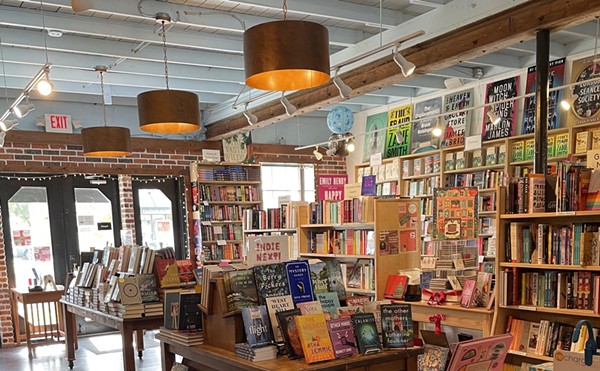As for the have-nots, Friday midnight at Platforms found about 20 folks dancing to Michael Jackson's "Billie Jean." The Realm, owned by strip-club maven Joe Redner, barely seemed open at all. "We lose money there," he says flatly. The Boneyard had a smattering of patrons drinking beer and playing pool. At the Blue Shark, a blues group played to a modest crowd. Same with the funky cover band at the Rare Olive.
It doesn't take an MBA to suss it out: Ybor City simply can no longer sustain this many bars. On the rain-threatened Saturday, 25 clubs were in operation on five blocks of Seventh Avenue.
The attrition is underway. Pleasuredome, Tahiti Joe's and Bar Tampa (word on the street says it will reopen soon as a new venue) were all closed, rendering the westernmost 14th Street block clubless (and no longer cordoned off to vehicles). Fat Tuesday, Inferno, Turbulence and Marty's Blues Café were also dark. Further closings pulse through the district's rumor mill.
So will Ybor City sink or swim?
Many of the historic district's most passionate advocates see some hope, or at least opportunity, amid the gloom. The time may be right to begin making over the party Mecca into a diversified community that incorporates a variety of retail, cultural and residential offerings. And bars too. It could emerge as Tampa's true urban enclave, one that doesn't only bustle on selected nights but moves to a variety of rhythms all the time.
"It's poetic justice that the bars are struggling," says Marcie Hoffman Porges, who owns the Hoffman Porges Gallery on Seventh Avenue. "But I don't buy into revenge. I think (the slump) was inevitable. But I still think Ybor City can be a great arts district with a lot of clubs, small businesses and coffeehouses. The city just needs to be more sophisticated in their decision-making. You don't make policy to promote a three-nights-a-week community."
'Bars are what built Ybor," says Tessa Shiver, who co-owns the Don Vicente de Ybor Historic Inn and lives on Seventh Avenue. She's right — about the current Ybor, anyway. Once a thriving neighborhood and workplace for Tampa's cigar workers, the district fell on hard times after World War II, when the cigar industry declined and residents migrated to other areas of Tampa. By the 1960s, many of the shotgun shacks and decrepit storefronts had been leveled during an urban renewal movement. It turned out to be more like urban removal. For decades, Ybor City has been heavily pocked with vacant lots.Hillsborough Community College set up a campus in 1974, lending an element of rejuvenation, but the vibe at night was bleak and threatening. Only the venerable Columbia Restaurant brought in crowds, who scurried back to their cars after dinner.
But a certain faction saw an opportunity. Artists, attracted by large, loft-like spaces, cheap rents and the district's distinctly old-urban ambience, set up studios and residences. Ybor gradually developed into boho-ville. Unique events like the Artists & Writers Ball, the underground's answer to Gasparilla, and WMNF's Tropical Heatwave cropped up. A few eateries and watering holes opened to cater to the artistically inclined. "In the early '80s, you had the Columbia on one end (of Seventh) and El Goya (once Tampa's dominant gay nightclub) on the other," Pardo of YCDC says. "We used to talk about filling in the center."
In 1990, Ybor City was named a National Historic Landmark, one of four in Florida. Two years earlier, it had been granted status by the city as a Community Redevelopment Area. This enabled the district to keep property taxes generated by its growth to use toward further development.
Funky independent shops like La France vintage clothing, Three Birds Bookstore and Blue Chair Music drew a counterculture clientele. Nighttime activity grew to include poetry readings, small theater, art auctions and mosh-heavy punk-rock shows. Boho-ville was getting bigger.
Ybor habitués liked the pace, but the city saw a chance to really jumpstart its long-blighted Latin Quarter. To spur growth, it offered a set of incentives to entice business people into the historic district. The rule requiring bars to be 1,000 feet apart was set aside. Stringent standards for keeping stormwater on site were dropped. Fees for businesses that did not provide parking were waived. So were transportation impact fees, which require each new business to pay for the traffic it dumps into surrounding roads.
The business sector that found these incentives most attractive? Bar owners. They swarmed Tampa City Council requesting "wet zonings," which permit alcohol to be served in a particular building.
The council complied, handing out wet zonings like Jolly Ranchers on Halloween. Nightclub owners, after all, came with the dough and inclination to refurbish dilapidated buildings. "If it was not for the relaxation of wet zonings, a lot of the buildings would have never been fixed up," Pardo says. Even so, few local pols gave much thought to what the historic district might become.















